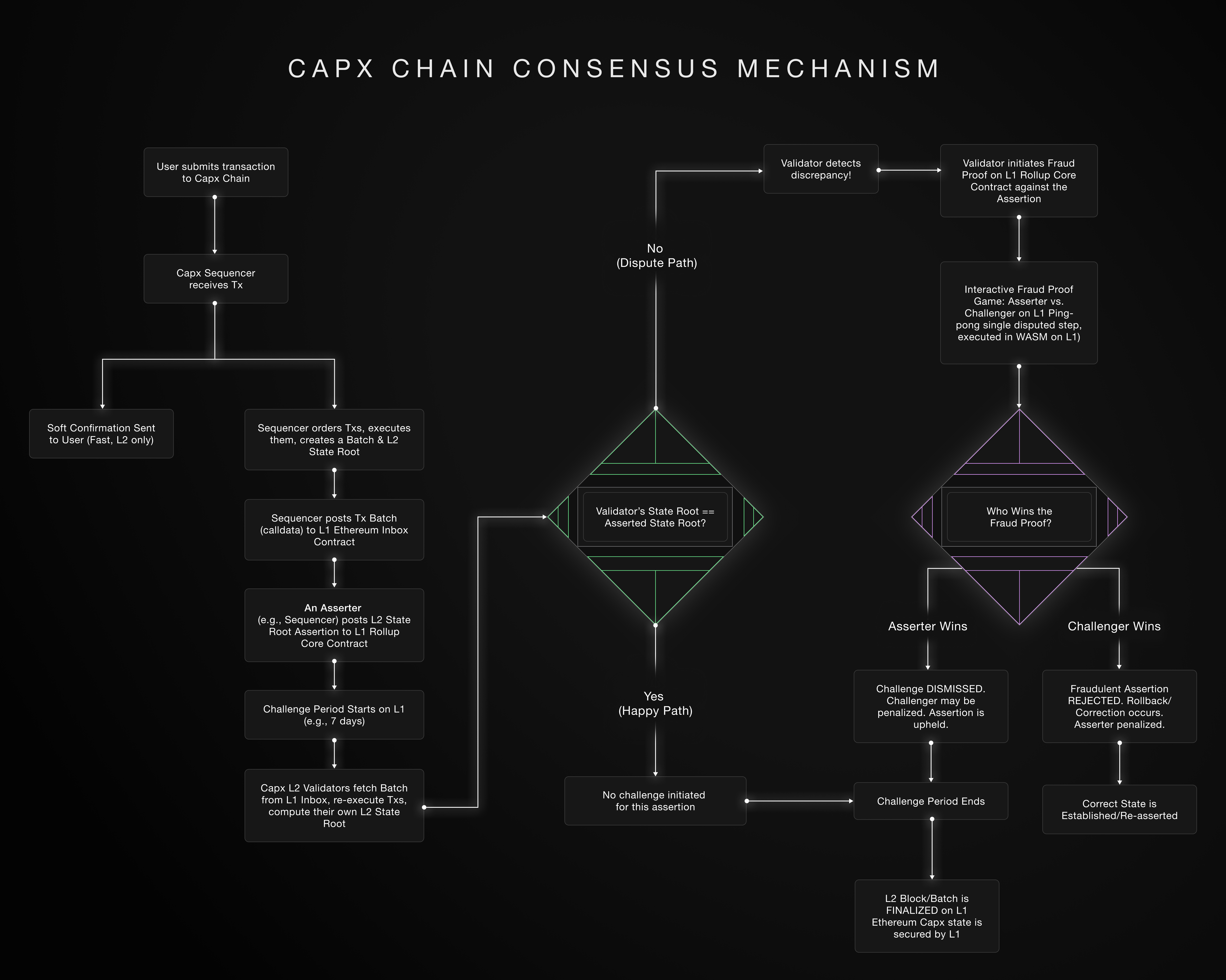
Capx Chain Consensus Flow
Capx Chain Consensus Flow
(L2: Capx Chain Execution & Proposal)
User ---sends L2 Tx---> [Capx Chain Sequencer][Sequencer]- Orders transactions.
- Executes transactions, computes new L2 state.
- Creates a
[Transaction Batch]and a new[L2 State Root_S]. - Provides
---Soft Confirmation---> User.
[Sequencer] ---submits Tx Batch (calldata)---> [L1 Ethereum: Inbox Contract]- Data is now anchored on L1, ensuring Data Availability.
[Asserter (e.g., Sequencer)] ---posts Assertion(L2 State Root_S)---> [L1 Ethereum: Rollup Core Contract][Rollup Core Contract] ---initiates Challenge Period (e.g., 7 days)---- During this period, any validator can challenge the assertion.
- Validators can independently verify the state root by executing the transactions in the batch.
- The challenge period allows for a dispute resolution process if discrepancies arise.
-
[Capx Chain Validators (L2 Full Nodes)]:- Fetch
[Transaction Batch]from L1 Inbox. - Independently execute transactions, compute their own
[L2 State Root_V]. - Compare
[L2 State Root_V]with asserted[L2 State Root_S]on L1.
- Fetch
-
Decision Point during Challenge Period:
- IF
State Root_V == State Root_S(Happy Path):- Validators take no action against this assertion.
IF Challenge Period Ends without successful challenge:[L1 Ethereum: Rollup Core Contract] ---confirms Assertion---> [L2 State Root_S is Finalized]✅- This is L1-Secured Finality for the L2 Block.
- IF
State Root_V != State Root_S(Dispute Path):[A Challenging Validator] ---initiates Fraud Proof against Assertion(L2 State Root_S)---> [L1 Ethereum: Rollup Core Contract]- Fraud Proof Process (Interactive Bisection in Nitro):
- The contract facilitates an interactive game between the Asserter and Challenger.
- They narrow down the dispute to a single differing instruction in the L2 execution.
- This single instruction is then executed via a WASM module on L1 (the
OneStepProofmechanism) to determine the correct state transition. IF Challenger Wins:Fraudulent assertion is rejected, Challenger is rewarded, Asserter is penalized. The correct state can be asserted.IF Asserter Wins:Challenge is dismissed, Challenger may lose their stake. Assertion proceeds towards finalization.
- IF
Key Components & Roles in Consensus:
-
Sequencer (L2):
- Role: A designated node (or a decentralized set of nodes in future iterations of Arbitrum technology) responsible for accepting user transactions, determining their order, executing them, and bundling them into compressed batches.
- Block Proposal (L2): The Sequencer effectively proposes L2 “blocks” or batches by creating an ordered sequence of transactions and calculating the resulting state transition. This provides users with fast, sub-second “soft” confirmations or pre-confirmations.
- L1 Interaction: Submits these transaction batches as
calldatato anInboxcontract on Ethereum L1. This ensures data availability.
-
Asserters (Typically includes the Sequencer, can be other permissioned L2 Nodes):
- Role: After L2 blocks are processed and data is posted to L1, an Asserter posts a cryptographic commitment (a state root) of Capx Chain’s new state to the
Rollup Corecontract on Ethereum L1. This is an “assertion” about the outcome of executing a specific batch of L2 transactions. - State Finalization (Path to): These assertions initiate a challenge period on L1.
- Role: After L2 blocks are processed and data is posted to L1, an Asserter posts a cryptographic commitment (a state root) of Capx Chain’s new state to the
-
Validators (Full L2 Nodes):
- Role: These nodes independently execute all L2 transactions from the data available on the L1
Inbox. They compute their own version of the L2 state root. - Verification: They compare their calculated state root against the state root asserted on L1 by the Asserter.
- Challenge Initiation: If a Validator detects a discrepancy (i.e., the asserted state root is incorrect according to their computation), they can initiate a fraud proof challenge on L1 during the challenge period.
- Role: These nodes independently execute all L2 transactions from the data available on the L1
-
Ethereum L1 Contracts (e.g.,
Rollup Core,Inbox,Bridge):- Role: These smart contracts on Ethereum are the arbiters of truth for Capx Chain.
Inbox: Receives transaction data from the Sequencer.Rollup Core: Manages the state of the rollup, tracks assertions, and facilitates the fraud proof mechanism.
- Finality: L1 provides the ultimate settlement and finality. An L2 state root is considered final once its assertion has survived the challenge period on L1, or a fraud proof has successfully defended it (or corrected a fraudulent one).
- Role: These smart contracts on Ethereum are the arbiters of truth for Capx Chain.
